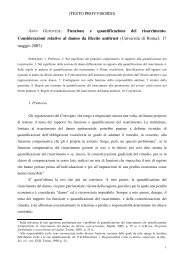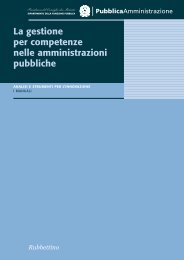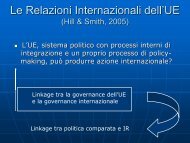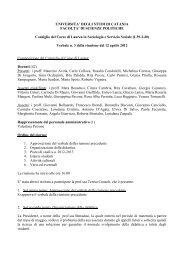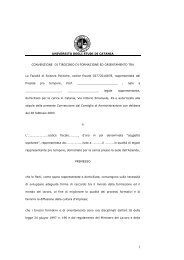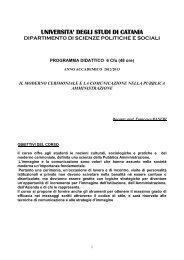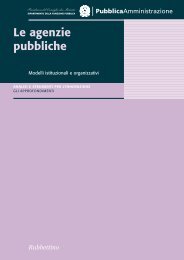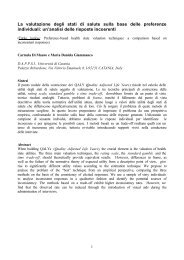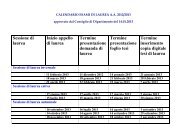(EUBAM) Libya
(EUBAM) Libya
(EUBAM) Libya
You also want an ePaper? Increase the reach of your titles
YUMPU automatically turns print PDFs into web optimized ePapers that Google loves.
ReSHAPE Online Papers Series, no. 03/13 – June 2013<br />
The EU Border Assistance Mission (<strong>EUBAM</strong>) in <strong>Libya</strong><br />
The European Union Integrated Border Management Assistance Mission in <strong>Libya</strong><br />
(<strong>EUBAM</strong>) is a civilian mission under the Common Security and Defense Policy (CSDP) aimed at<br />
supporting the <strong>Libya</strong>n authorities in enhancing and developing the security of the country’s borders.<br />
In particular, the mission entails two kinds of objectives, in the short term the security of land, sea<br />
and air borders, in the long term a broader Integrated Border Management (IBM) strategy. The way<br />
to achieve these objectives is mainly the transfer of know-how. No executive function is envisaged.<br />
In fact, the planned activities consist of “training and mentoring the <strong>Libya</strong>n authorities in<br />
strengthening the border services in accordance with international standards and best practices”; “to<br />
advise the <strong>Libya</strong>n authorities on the development of a <strong>Libya</strong>n national IBM strategy”; “to support<br />
the <strong>Libya</strong>n authorities in strengthening their institutional operational capabilities” (Task, art. 3 a, b,<br />
c). 2<br />
The mission responds to an invitation by <strong>Libya</strong> and is part of the EU’s comprehensive<br />
approach to support the <strong>Libya</strong>n post-conflict reconstruction, and specifically to contribute to stateconsolidation,<br />
economic development and the fight against organized crime and terrorism.<br />
Border control: a complex issue, a regional challenge<br />
As above mentioned, this mission is part of the EU’s comprehensive approach in the <strong>Libya</strong>n<br />
post-conflict reconstruction, so it is in line with the package of activities, listed in the previous<br />
section, the EU has implemented during the last two years in <strong>Libya</strong>. It is particularly important<br />
because it addresses a relevant issue in the <strong>Libya</strong>n transition and concerns a field where the EU<br />
would continue to work: disarmament, demobilization and reintegration. What differentiates<br />
<strong>EUBAM</strong> <strong>Libya</strong> from other activities is the complexity and the extension of the issue the EU has<br />
committed to face. That is to say that the <strong>Libya</strong>n borders’ control should be seen in a wider regional<br />
perspective, considering the Maghreb and the Sahel regions. This task entails coordination with the<br />
other CSDP mission in the wider region, namely EUCAP SAHEL Niger and EUTM Mali.<br />
Furthermore, the <strong>EUBAM</strong> mission should be considered as part of an international effort aimed at<br />
developing and supporting security sector reform in line with UN Security Council Resolution<br />
1973(2011) on <strong>Libya</strong>.<br />
It is worth underlining that <strong>Libya</strong> is a large country, bordered by the Mediterranean Sea to<br />
the north, Egypt to the east, Sudan to the southeast, Chad and Niger to the south, and Algeria and<br />
Tunisia to the west. It has a 4.348 km land border and 1.770 km maritime border which are difficult<br />
to control and porous to mass migration flows (south-south immigration) and to access by criminal<br />
organizations (arms and drugs trafficking and terrorist activities).<br />
The proliferation of weapons from <strong>Libya</strong> continues at an “alarming rate”. <strong>Libya</strong> arms have<br />
flowed to more than 12 countries and have fueled conflicts in Syria, Mali and elsewhere, boosting<br />
the arsenals of extremists and criminals in the entire region. As an instance, the jihadist of the<br />
MNLA (National Movement for the Liberation of Azawad), responsible for the military campaign<br />
of the Northern Mali and numerous atrocities, had previously served in Gaddafi’s military. 3<br />
The migratory phenomenon has a double movement, inward and outward. It has gained an<br />
increasing importance since the beginning of 2012 and has involved young people from tribes<br />
located near the borders, and networks of smugglers. In some territories, it has given place to the<br />
2 COUNCIL DECISION 2013/233/CFSP of 22 May 2013 on the European Union Integrated Border<br />
Management Assistance Mission in <strong>Libya</strong> (<strong>EUBAM</strong> <strong>Libya</strong>), http://eurlex.europa.eu/LexUriServ/LexUriServ.douri=OJ:L:2013:138:0015:0018:EN:PDF<br />
p.1<br />
3 UN Security Council report, 9 March 2013, Final report of the Panel of Experts established pursuant to<br />
resolution 1973 (2011) concerning <strong>Libya</strong>, http://www.securitycouncilreport.org/atf/cf/%7B65BFCF9B-6D27-4E9C-<br />
8CD3-CF6E4FF96FF9%7D/s_2013_99.pdf<br />
Francesca Arcidiacono, EU Border Assistance Mission (<strong>EUBAM</strong>) <strong>Libya</strong>: Testing EU Actorness - 4



